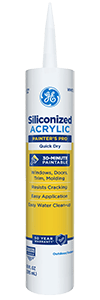When installing new baseboards, there’s a small gap between the baseboard and the wall. You should seal this gap with caulk before painting the baseboards to create a clean, professional-looking finish. If you have shoe molding on your baseboards, you can also seal the joint where the molding meets the baseboard to create a smooth look over the entire feature.
Old, peeling or cracked caulking around your baseboards means it’s time to reseal them. Not only is the old caulk unsightly, the cracks in the seal can let in unwanted drafts from outdoors or your home’s crawl space or basement. Plus, if you’re repainting, you’ll find a new, in-tact seal much easier to paint.
Tools & Supplies for Sealing Baseboards
Picking the right caulk can make all the difference. For sealing a baseboard or any dry area you plan to paint after sealing, choose a GE-branded siliconized acrylic caulk, like GE Painter’s Quick Dry caulk. This caulk is paint-ready in as little as 30 minutes1 or immediately spray-paint-ready, and because it’s siliconized, it’s permanently flexible and will resist cracking even after being painted. GE Painter’s Quick Dry caulk also comes with a 50-year limited durability guarantee,2 so you won’t have to reseal your baseboards for a long time.
Besides a GE-branded caulk, you will also need:
- Caulk gun
- Painter’s tape
- Latex gloves
- Soapy water
- Paper towels
- Utility blade
- Caulk tool
- Isopropyl alcohol
Once you have your GE-branded caulk of choice and all your supplies, you’re ready to seal and prep your baseboards for a perfect paint job:
-
Start with a Clean Surface
Whenever you start a new sealing project, make sure you have a clean work surface by wiping it down with isopropyl alcohol. If you’re replacing old caulk or sealant, completely remove it first, then wipe down the area with isopropyl alcohol. Let the surface dry before laying a new bead.
-
Apply Painter’s Tape
For a smoother bead and easier cleanup, apply painter’s tape on either side of the area you’re caulking.
-
Carefully Cut the Caulk Cartridge
Next, prepare your caulk by cutting the tip of the cartridge. Cut the cartridge tip at a 45-degree angle. Some caulk guns have a tool to cut the cartridge tip, but we recommend using a utility blade for consistently clean results. Cut off less than you think you’ll need because you can always cut more. Once cut, pierce the cartridge’s inner foil seal using the metal rod on your caulk gun or a long nail. Then load the sealant cartridge into the caulk gun.
-
Apply Caulk
Now you’re ready to begin sealing. Start at one end of the baseboard and work your way to the other end. Pull the gun toward you and maintain a relaxed, confident grip and steady speed to apply the bead smoothly. If you can’t make it in one pass, it’s ok to readjust your grip and start where you left off. Fill in any additional gaps as needed.
Repeat this process for the entire room that you’re sealing.
-
Tool the Bead & Remove the Painter’s Tape
Use a caulk tool or your finger to tool the caulk bead until it’s smooth. It’s important to tool the bead before the caulk starts to dry, so if you need to, you can tool in sections. Run a bead of caulk, tool the bead, then repeat as many times as needed.
-
Let Caulk Dry Completely
Finally, allow the caulk to dry completely for the best performance. GE Painter’s Quick Dry caulk is paint-ready in 30 minutes1 and fully dry in 24 hours, but check your product for specific drying and curing instructions.Now your baseboards have a long-lasting seal and are prepped for you to paint. For more step-by-step sealing tutorials with high-performing GE-branded caulks and sealants, check out our other How-To guides.
1Sealant can be spray-painted immediately and brush- and roller-painted in as little as 30 minutes with bead size max 3/16″, temperature minimum of 65°F, and humidity minimum 50 percent. Otherwise, sealant should not be painted for 30-minutes. Apply paint with reduced applicator pressure to avoid disturbing the sealant. Paintable Silicone Sealant works well with most water-based acrylic paints. Sealant is not recommended with oil-based paints. If oil-based paints are used, test apply an acrylic primer and paint in a small, inconspicuous area.
2Manufacturer warrants that this product, when used as directed, will meet the above specifications for as long as you own your home. If not satisfied, return proof of purchase for refund. This is the sole and exclusive remedy and Manufacturer shall not be liable for any damages in excess of the purchase price. This warranty is in lieu of all other warranties, express or implied, including any warranty of merchantability or fitness.

